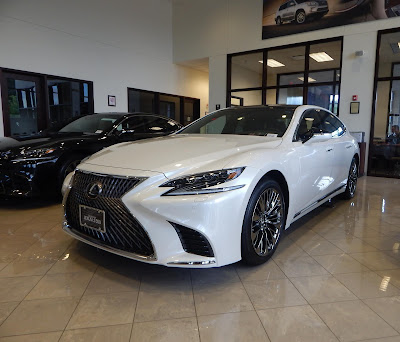The LS is more than Lexus's flagship sedan. It is the car that launched the entire brand back in 1989 and caused people around the world to rethink their idea of luxury cars. Nearly thirty years later, the fifth generation LS is here to bring the fight back to the Germans it once sent scrambling to their drawing boards.
While previous generations of the LS were staid and reserved, the all new 2018 LS is confident in its own skin and ready to assert its place at the top of the luxury sedan market. It comes with its own angular design language which proudly shows off its Japanese heritage. The centerpiece of the car's design is undoubtedly its signature spindle grille. More than 5,000 individual surfaces are arranged by hand to create an intricate woven pattern unlike anything else. The overall silhouette of the new LS is far more streamlined than its predecessor. A gently sloping roof and a short trunk lid give the car a coupe-like appearance more similar to the Jaguar XJ and the Porsche Panamera than the upright designs of the Audi A8 and the Mercedes-Benz S-class.
Inside, the LS is as luxurious as ever. I mentioned in a previous post that the LS is among the quietest cars in the world. It's all part of a concept of hospitality called omotenashi in Japan. An Executive Package brings 22-way power adjustable rear seats with built-in massaging function. The right rear seat can even come equipped with a sliding ottoman. Adaptive variable air suspension raises and lowers the car to make entrance and egress easier for occupants. Other stylistic touches that draw inspiration from Japanese culture include magnesium accent lines along the dashboard meant to resemble a traditional koto harp, and ambient lighting said to mimic the warm glow of andon lanterns.
One optional feature worth mentioning is the kiriko glass set in the car's door panels. Kiriko is a unique Japanese tradition of hand-cutting patterns into glass to create stunning reflections of light. Each piece of glass requires up to 147 points of polishing, which can take up to two hours to complete. This feature can only be had on models equipped with the Executive Package and also comes bundled with hand-pleated interior door trim formed from a single piece of extra soft cloth and folded in traditional origami style.
All LS models are now called LS 500. The name signifies a change from the old 4.6 liter V-8 in favor of a new twin turbocharged 3.5 liter V-6. Rated at 416 horsepower and 442 lb-ft of torque, it's good to get the big Lexus from zero to 60 in 4.6 seconds. Forced induction yields an improvement of 36 horsepower and 75 lb-ft of torque over the outgoing V-8 powerplant. Fuel economy is likewise higher at 19 mpg city and 30 mpg highway compared to 16 mpg city and 24 mpg highway for the old car.
For those looking for even better fuel economy, there is also a new LS 500h hybrid. Unlike the previous generation LS hybrid which used a high output electric motor and nickel hydride battery packs, the 2018 model features two electric motors and a compact lithium ion battery. The engine is also different. Although still making 3.5 liters of displacement, the hybrid uses an Atkinson cycle unit without turbochargers. Lexus is proud to announce that this is the first multistage hybrid in its class, and its combined fuel economy gains of 5 mpg over the conventionally powered car will certainly leave you pleased.
We've seen Lexus recently dip its toes into the performance arena with F Sport models of several of its offerings. The trim debuted on the old LS during its midcycle refresh in 2013 and is offered from the outset with the 2018 model. It consists of several exterior and interior styling changes as well as sharper suspension and bigger brakes. But helping the car's sporting credentials this time around is a platform shared with the sublime LC 500 coupe. This switch gifts the LS with a lower ride height and an improved center of gravity.
You may specify additional handling improvements through an optional Performance Package. Checking this box on your F Sport order form grants you active rear steering, active stabilizers, and a nifty variable gear ratio steering system which changes the number of turns lock-to-lock you can perform with the steering wheel. A quicker ratio with fewer turns gives the vehicle a more nimble feel. Switching to a slower ratio with more turns imparts a better sense of stability, especially at high speeds.
Prices for the new LS start around $75,000 which is roughly $15,000 less than a Mercedes S-class and $8,000 less than a BMW 7-series. You also get several features as standard on the Lexus that are costly options on the Germans. Every LS leaves the factory with dual zone climate control, heated steering wheel, power moonroof, Lexus Safety System+, blind spot monitor, parking assist, a navigation system, and a 12 speaker audio system.
No longer content imitating the competition, the 2018 Lexus LS comes across as a distinctly Japanese entry in the full size luxury sedan segment. It's impeccable build quality, thoughtful design details, and improved dynamics should have more than a few German executives worried.





